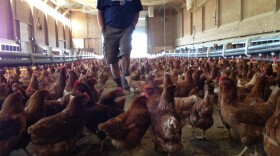The peak of the summer harvest is approaching, which means that if you have a community supported agriculture share, you may be receiving a daunting amount of fresh produce to cook every week.
In recent years, the has been attracting thousands of new farmers and consumers. Farmers like CSAs because they get money to cover the costs of production at the beginning of the season. Consumers who buy in get to connect with local food producers, who provide them with fresh, and often novel, produce items. The price of a share varies significantly, but one of CSAs in California's Central Valley found that they average about $25 per week.
Most operations are small, serving a few hundred customers or less. But some serve thousands. And last year, an organic CSA of more than 5,000 members — one of the country's largest — went .
Which raises the question: Can a CSA program get too big?
According to the study of CSAs in California's Central Valley, a big CSA is usually the sign of a highly diversified farm.
"Very often the larger farms [with CSAs] actually have a smaller percent of their sales from CSAs," because they have other, bigger points of sales, says , the University of California, Davis professor who headed the study. "They're more likely to rely on a huge number of different outlets: farmers markets, CSAs, direct to restaurant, direct to retail and also wholesale."
And complexity can lead to debt and other problems.
In northern Colorado, Grant Family Farms started with just 127 members in 2007 and grew to more than 5,000 in 2012. The share program — which offered customers everything from salad greens, kale, spinach and herbs to rhubarb, squash and beets — was just a small part of the overall operation. Former owner Andy Grant estimates that about 80 percent of the farm's business was growing vegetables for sale in grocery stores and other commercial outlets.
The business had its ups and downs, Grant says. After struggling through Chapter 11 bankruptcy in 2006 and 2007, Grant accepted a $1.5 million loan from a consortium of investors called Localization Partners.
By December 2012, the farm declared Chapter 7 bankruptcy — which effectively ended operations.
"The problem with our farm was not its size," says Grant, who remains passionate about organic farming and has already started a new CSA. "In fact, within the farm, the CSA was probably one of the most dynamically well run, profitable things we did." Community connections to his CSA remained strong until the end, he notes.
Grant Family Farms had dozens of distribution points across Colorado's Front Range, from Colorado Springs to the northern Wyoming border. That's compared with a smaller operation where members might pick up their share every week from the farm.
"If you're going to take seriously the 'community' component of it, and if one of your goals is to have strong ties with your members and have your members have strong ties with you, maybe there is a point where the CSA can't really get any bigger," says , an outreach specialist at the University of Wisconsin-Madison's Center for Integrated Agricultural Systems who studies small vegetable farms.
Hendrickson helped conduct a of farms in 1999 using the CSA model to find out the characteristics of farms, operators and income. The survey found that the CSA model worked for a wide range of farm sizes as a primary or secondary enterprise.
For Jean-Paul Courtens, who owns , a biodynamic farm in New York's Hudson Valley, the focus shouldn't be on size. His farm is primarily focused on CSA memberships and supports 1,100 members — a level he's sustained for the past seven years.
"We hit what we called a sweet spot," he says. "If we wanted to expand — which we didn't want to — to 2,000 members, we would have fairly quickly outgrown the equipment we had, and be faced with purchasing equipment that would almost be too big for us."
In his mind, Courtens says the question should be about whether CSA farms maintain strong connections with their customers and those who harvest the land.
"When size becomes a factor in dehumanizing the whole transaction, yes, you are too big," he says. "Where is that? I don't know."
Grace Hood reports from Colorado
forKUNC
and ,
a public radio reporting collaboration that focuses on agriculture and food production issues.
of this post
appeared earlier on the Harvest Public Media website.
9(MDAxNDQ2NDAxMDEyNzU2NzM2ODA3ZGI1ZA001))
Copyright 2013







